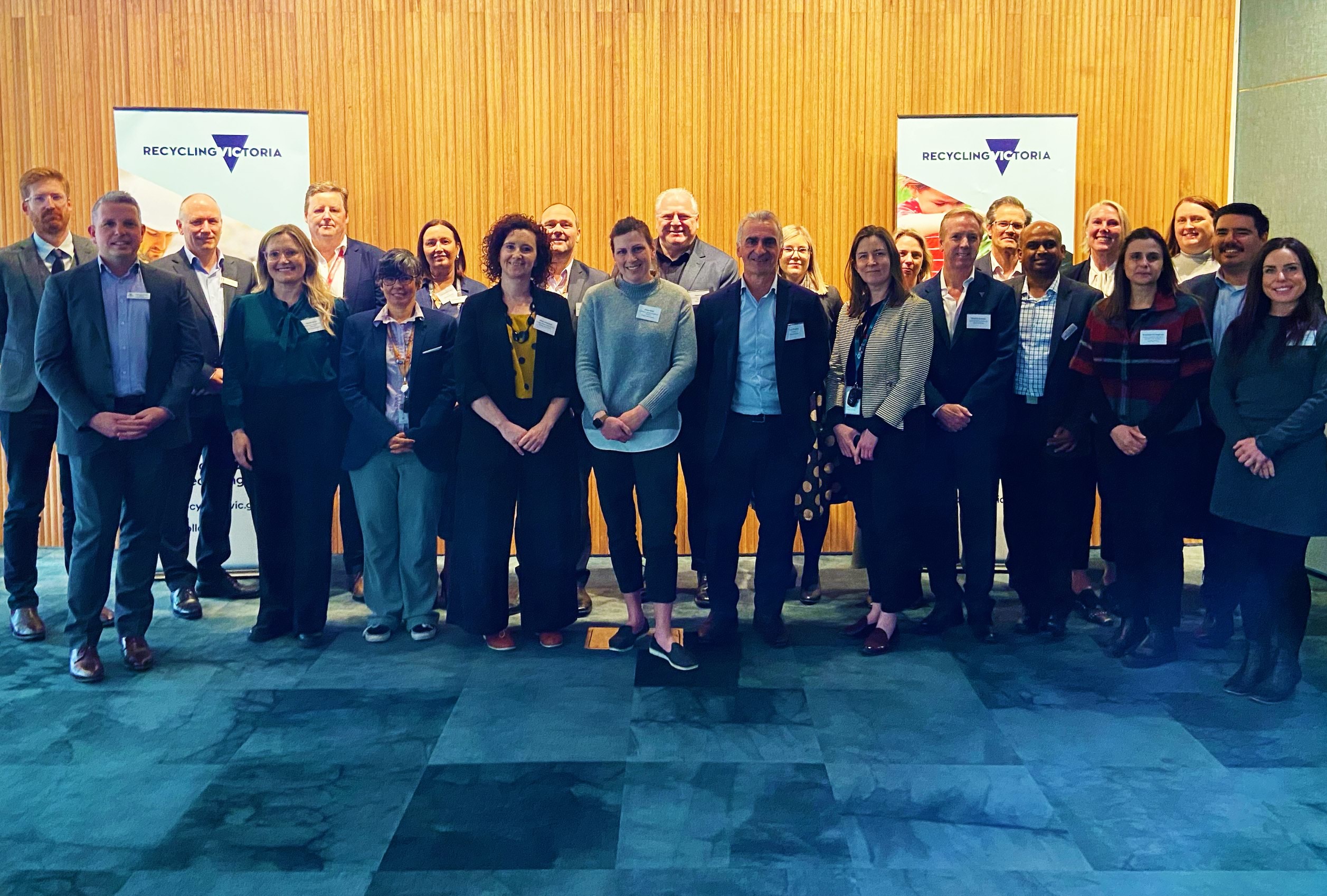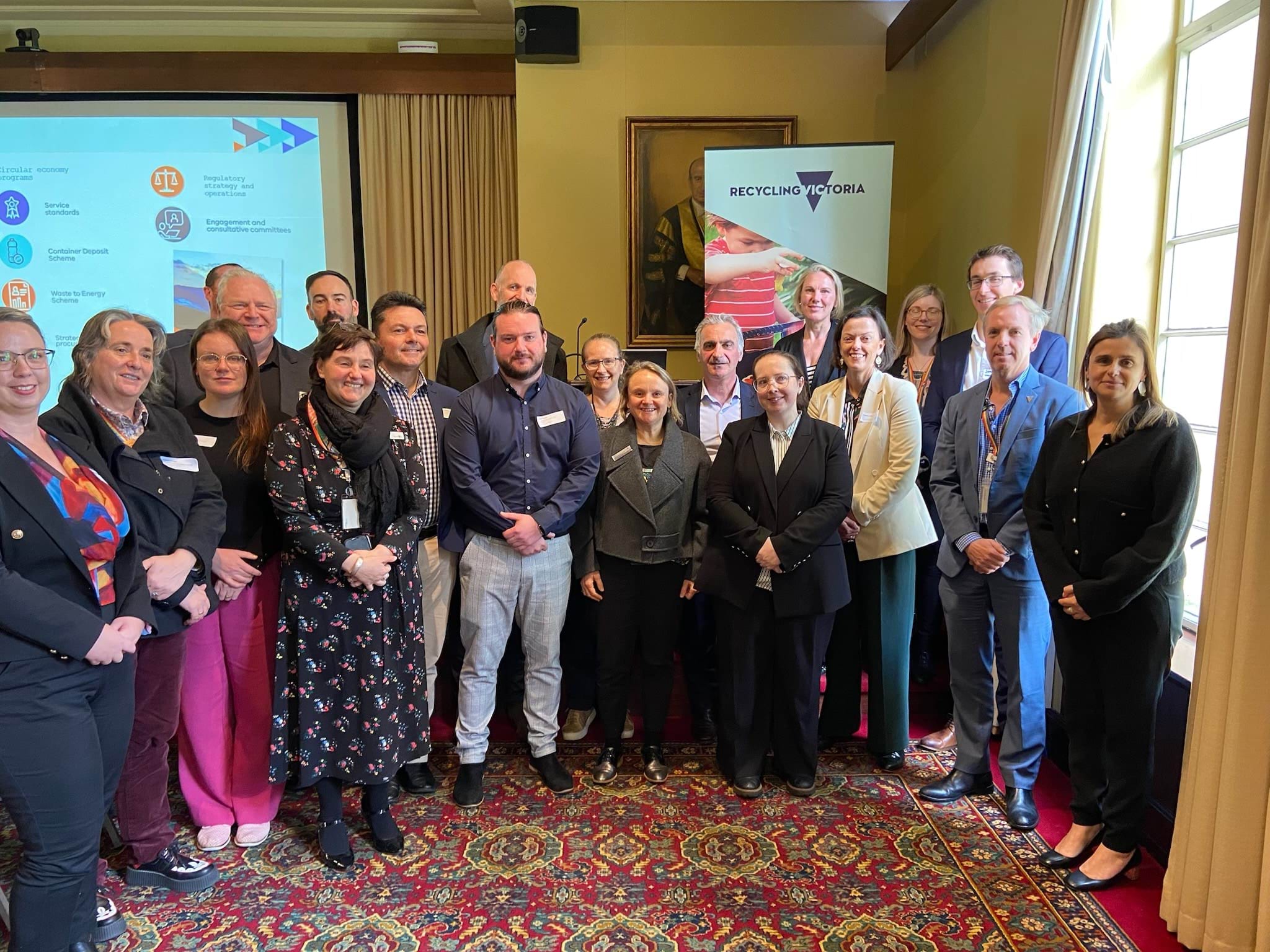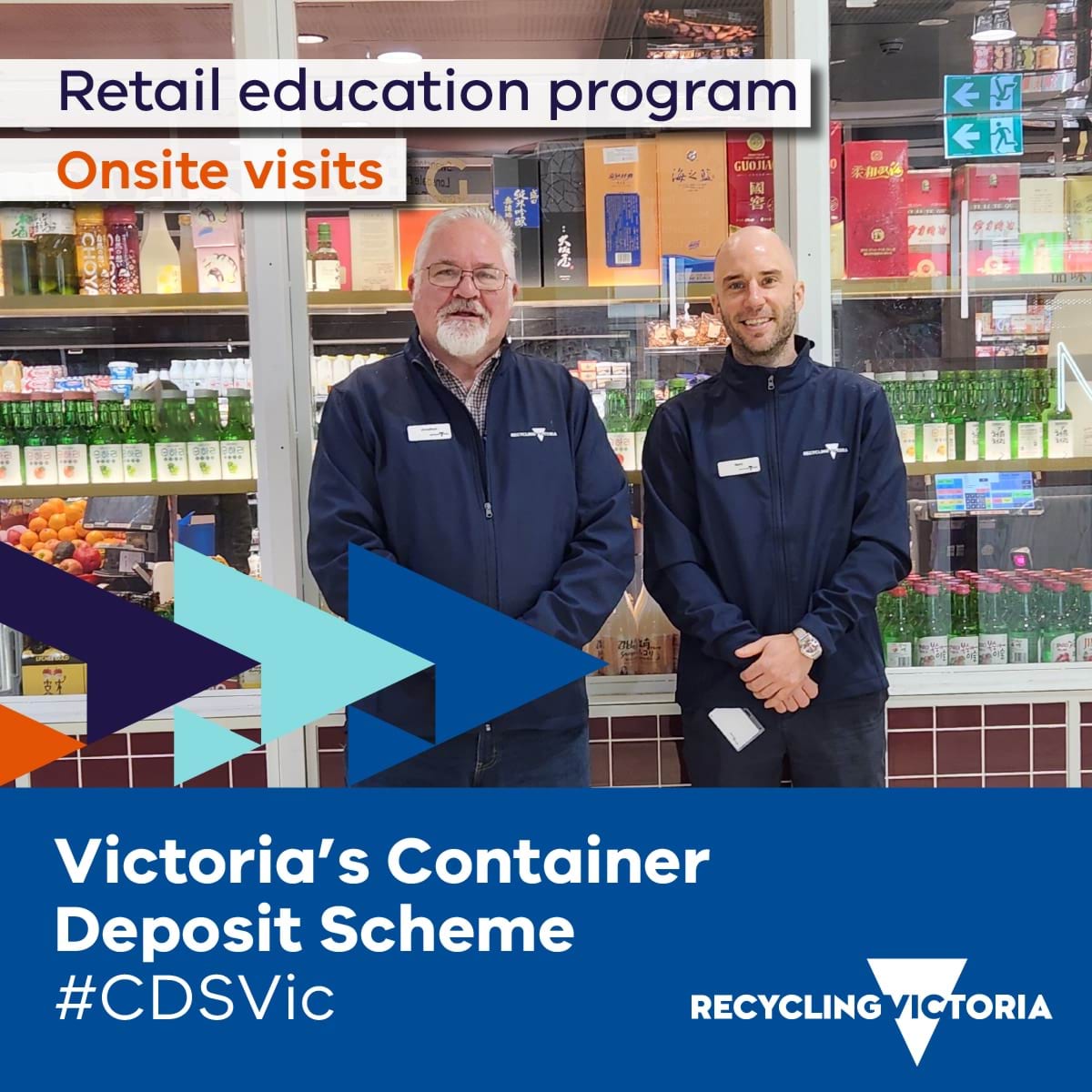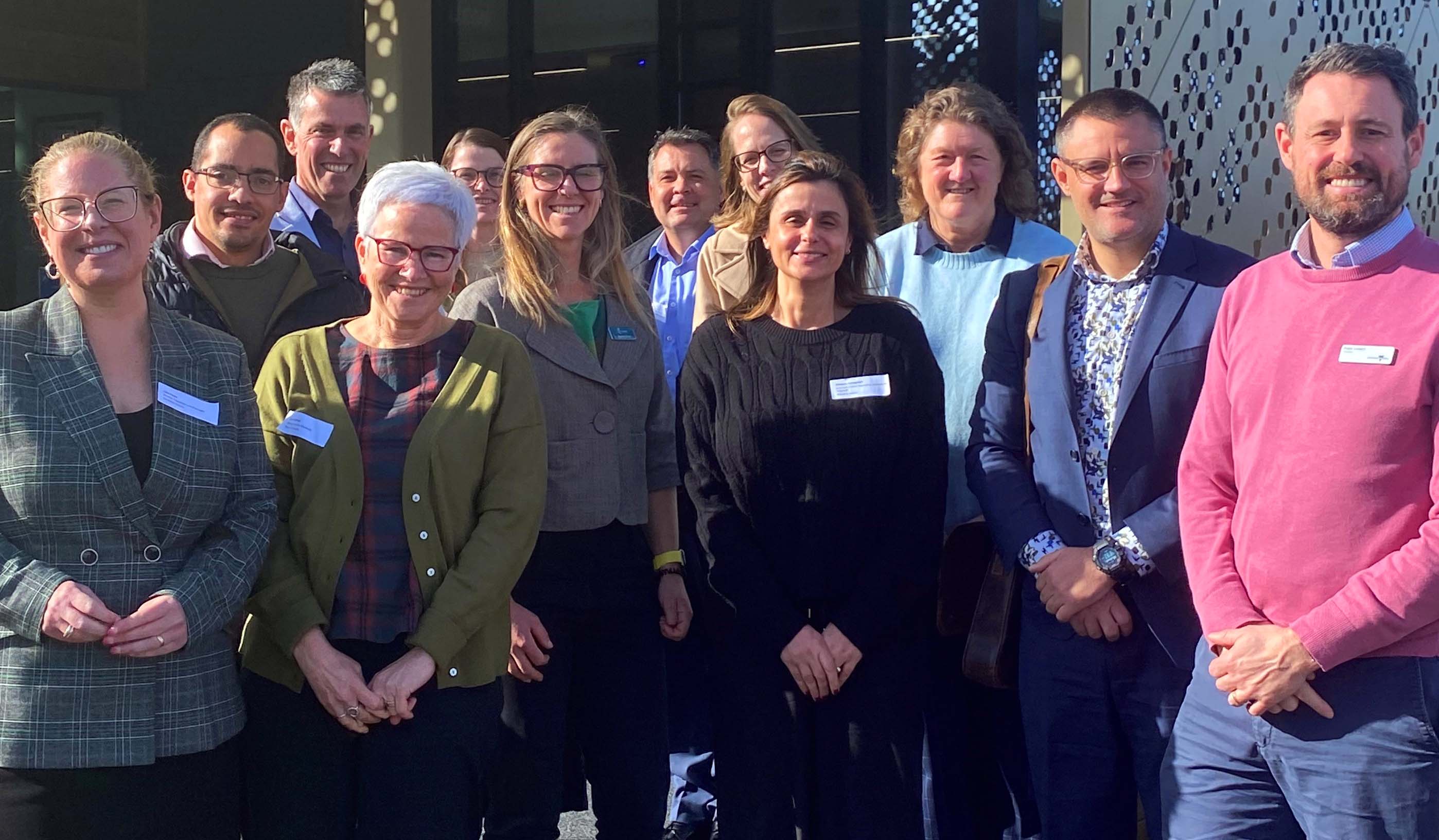Stay up to date
Find out more about what's going on in the waste, recycling and resource recovery sector, check out our latest news bulletin.
Sign-up to receive each new edition
Recent news items
18 November 2025
We’re committed to working with local government on issues that matter to them, decisions that affect them and opportunities involving them.
So, it was great to hear from councils in the south eastern metropolitan region of Port Phillip at our round table discussion today.
Topics of discussion included:- Victoria's Waste to Energy Scheme
- the forthcoming Household Waste and Recycling Service Standard
- waste management infrastructure planning
- product stewardship and problematic material streams.
A big thank you to...
- Banyule City Council, Allison Beckwith and Darren Bennett
- Bayside City Council, Jordan Allan
- Cardinia Shire Council, Misty Johannsen
- City of Greater Dandenong, Sanjay Manivasagasivam
- City of Kingston, Tim Scott
- Maroondah City Council, Tony Rocca
- City Of Monash, Andi Diamond
- Mornington Peninsula Shire, Davey Smith
- Nillumbik Shire Council, Hannah Burns
- Whitehorse City Council, Steven White
- Yarra Ranges Council, Kathleen McClusky and Corinne Bowen
- Darebin City Council, Rachel Ollivier
- Yarra City Council, Lisa Coffa
...for taking the time to connect and share your insights with us.
12 November 2025
Launching in November 2023 the last 2 years of operation has seen CDS Vic achieve some significant milestones.
The Victorian Government knows that taking action makes a difference. The results of a recent litter data audit show that litter from containers that are eligible in the CDS has dropped 71% since CDS Vic began. That’s a great impact and response from the community.
In the past 2 years Victorians have returned over 2.34 billion containers and received over $234 million in refunds. January 2025 was the biggest month so far, with 137 million containers returned through public refund collection points. Containers can be returned to at one of the 630 plus refund collection points across the state. Additionally, 857 million containers were recovered at Materials Recovery Facilities from scheme commencement to 30 June 2025.
CDS Vic has created new economic opportunities, generated new jobs and turned drink containers into new recycled products.
Charities, schools, sports club, and community organisation have benefited from new ways to raise funds, with more than 6,000 donation partners now registered. In the last 2 years over $2.6 million has been raised for donation partners.
Across the state, CDS Vic is working with community groups like Scouts and well known sporting organisations like the AFL Victoria, Carlton Football Club, Cricket Victoria and Tennis Victoria to ensure we reach as many Victorians as possible.
Through Resource Smart Schools one primary and one secondary school won the inaugural CDS Vic Resource Smart Schools award raising awareness of the scheme with our younger cohort. And the Win a Million Cents campaign saw 5 lucky residents and donation partner Our Haven Shelter receive $10,000 each!
To celebrate the CDS Vic 2nd anniversary Scheme Coordinator Vic Return will be running a social media competition for the month of November to get the biggest fans in on the action, where passionate container collectors can show their love for the scheme and win prizes while they’re at it.
Recycling Victoria, the regulator of CDS Vic, has been conducting retail education visits to ensure all retailers are aware of their obligations under the scheme, with refunds of registered eligible containers available at one of the 630 plus refund collection points across the state.
CDS Vic is part of the Victorian Government's $515 million investment to transform the state's waste and recycling sector. Funded by contributions from the beverage industry, CDS Vic is contributing to Victoria's target of diverting 80% of all material away from landfill by 2030 and represents a significant milestone in our journey towards a circular economy.
12 November 2025
Victoria's Container Deposit Scheme (CDS Vic) is transforming the way we manage beverage containers by:
- increasing the volume and quality of recycling
- optimising reuse
- reducing drink container litter across the state.
CDS Vic is an important part of building Victoria’s circular economy and since its launch in November 2023 there’s been a 71% reduction in eligible drink container litter.
Before the program began, drink containers accounted for nearly half of all litter in the state.
Today, that number is dropping steadily thanks to:- shared responsibility between producers, retailers and consumers through a product stewardship model
- a convenient and accessible network of refund points
- the incentive of a 10-cent refund for every eligible container.
During Planet Ark's National Recycling Week, Recycling Victoria celebrates the success generated by those who have embraced CDS Vic and are doing their bit for a cleaner, greener Victoria.
To find out more, visit our CDS Vic page10 November 2025
It’s National Recycling Week and we’re focused on helping individuals, community and industry to:
- improve recycling and waste management
- reduce landfill
- strengthen our circular economy.
To start the week, we’re featuring someone who knows a thing or two about recycling and the circular economy - Tony Circelli, Head Recycling Victoria.
Tony recently joined George Hatzimanolis and the team at Repurpose It on their latest ‘Living with Purpose’ podcast, sharing insights into the innovations and reforms shaping our circular future.
Tune in as they unpack key topics like:- market data and intelligence
- product stewardship
- Victoria's Container Deposit Scheme
- infrastructure planning
- regulation and compliance.
We believe in sharing what we do and why it matters - listen to the conversation via:
We also encourage you to take National Recycling Week’s call to action to get involved. Find out more at Planet Ark
31 October 2025
Recycling Victoria’s 2024–25 Annual Report has been tabled in Parliament.
Now in our third year of operation, Recycling Victoria has continued to deliver our program, mature our services and began the integration of our activities in a holistic stewardship approach that responds to emerging industry challenges.
Key activities detailed in the Annual Report include:
- release of the inaugural Victorian Recycling Infrastructure Plan and investment prospectus
- Victoria’s Container Deposit Scheme’s first birthday milestone and return of 1 billion containers
- completion of the expression of interest process for applicants wishing to apply for a thermal waste to energy cap licence as part of the Waste to Energy Scheme
- development of the Compliance and Enforcement Policy
- publishing the Strategic Procurement Framework
- publishing the second Circular Economy Market Report
- development and release of the second Circular Economy Risk, Consequence and Contingency Plan.
View the 2024–25 Annual Report.
23 October 2025
Don’t miss hearing from Recycling Victoria’s Tony Circelli, Deb Cailes and Ashleigh Jones at this year’s Waste Expo Australia 29 – 30 October 2025.
- Wednesday 29: Priorities to advance the circular economy in Victoria
Tony Circelli - Head, Recycling Victoria
We look forward to Tony and Sustainability Victoria's Matt Genever teaming up to explore strategic priorities driving Victoria’s transition to a circular economy.
Together, they will examine the opportunities, challenges and role of collaboration in creating and supporting circularity across the state.
- Wednesday 29: Waste to energy - cap licensing in Victoria
Ashleigh Jones - Director, Regulation and Oversight
Learn about the latest developments in Victoria’s Waste to Energy Scheme with an update from Recycling Victoria.
This session will unpack the outcomes of the cap licence process for thermal waste to energy facilities and explore what it means for the future of sustainable waste management in the state.
- Thursday 30: Panel discussion: strengthening data and reporting for a circular future
Deb Cailes GAICD - Executive Director Strategy, Procurement and Planning
Explore how improving national waste data and reporting can unlock smarter decision-making, better policy and real progress toward a circular economy.
This session will bring together experts working to standardise data collection, close reporting gaps and enhance transparency across the waste and resource recovery sector. Discover the tools, collaborations and innovations driving a clearer picture of our national waste landscape.
Drop by the Government Lounge for a chat with the teams from:
- Recycling Victoria
- Environment Protection Authority Victoria (EPA)
- Sustainability Victoria
- Department of Energy, Environment and Climate Action
Find out more about Waste Expo Australia.
- Wednesday 29: Priorities to advance the circular economy in Victoria
17 September 2025
It was great to hear from local government on the issues and opportunities facing inner city and western metropolitan councils as part of the Port Phillip region round table discussion last week.

Topics of discussion included:- Victoria's Waste to Energy Scheme
- the forthcoming Household Waste and Recycling Service Standard
- management of used and unwanted batteries and illegal dumping.
A big thank you to...
- Mark Rossiter and Amanda Smith, Wyndham City Council
- Debbie Wood and Amanda Dodd, City of Whittlesea
- Anita Curnow, Merri-bek City Council
- Helen Sui, Moonee Valley City Council Vince Macolino, City of Melbourne
- Niall McDonagh and Jess Wingad, Glen Eira City Council
- Lachlan Johnson, City of Port Phillip
- Tom Razmovski, Brimbank City Council
- Mike McIntosh, Maribyrnong City Council
- Dave Power, Hobsons Bay City Council
- Sheena Frost and Danielle Prentice, Hume City Council
- Simon Holloway, City of Stonnington
- Stephen Chapple, Department of Energy, Environment and Climate Action
...for taking the time to connect and share your insights with us.
21 August 2025
It might not be on your radar right now, but it’s on ours…Australia has the world's highest per capita disposal (waste) rate for textiles and clothing.
It’s a circular economy challenge for us all - government, industry and consumers both here and around the world.
A big part of Victoria’s transition to a sustainable circular economy is supporting and investing in business-led innovations and solutions that reduce textile waste and improve resource recovery.
So, it was a privilege to be joined by world-renowned expert in sustainable innovation Professor Dr. Jacqueline Cramer (Utrecht University, the Netherlands) who provided insight into the Dutch experience of industry-driven leadership in circular economy.
Key areas of focus and discussion were:
▪️ lessons and insights from the Dutch Circular Textile Valley - Textielregie experience of growing textile circularity at scale
▪️ the power of coalitions of the willing using network governance to make headway on waste challenges
▪️ the opportunities for investment in Victoria’s capability and capacity for textile resource recovery, recycling and re-commerce.
Thank you to our participants from the textiles, recycling and resource recovery, waste and research and innovation sectors for the lively conversation and insights.
Recycling Victoria was pleased to team up with Invest Victoria, Embassy and Consulate-General of the Kingdom of the Netherlands in Australia and the NBSO-Melbourne (Netherlands Business Support Office) in delivering the forum.
Prof. dr. Jacqueline Cramer’s visit has been made possible through funding by the Netherlands Enterprise Agency (RVO) to stimulate international cooperation in the energy transition.20 August 2025
𝗪𝗮𝘀𝘁𝗲 𝘁𝗼 𝗲𝗻𝗲𝗿𝗴𝘆 𝗰𝗮𝗽 𝗹𝗶𝗰𝗲𝗻𝗰𝗲𝘀 𝗶𝘀𝘀𝘂𝗲𝗱
Recycling Victoria has reached a significant milestone with the issuing of 7 thermal waste to energy cap licences.
Once all other regulatory approvals have been obtained, waste to energy facility operators with a cap licence will be allowed to develop facilities capable of processing permitted waste up to a specified maximum amount at their facility.
𝗩𝗮𝗹𝘂𝗲 𝗳𝗿𝗼𝗺 𝘄𝗮𝘀𝘁𝗲 𝘁𝗵𝗮𝘁 𝘄𝗼𝘂𝗹𝗱 𝗼𝘁𝗵𝗲𝗿𝘄𝗶𝘀𝗲 𝗴𝗼 𝘁𝗼 𝗹𝗮𝗻𝗱𝗳𝗶𝗹𝗹
Landfills are filling up and Victoria will start to run out of landfill capacity in the mid-2030s. Securing infrastructure that can process large quantities of waste that can’t be recycled is a high priority for Victoria.
Only waste that can’t be recycled can be treated in thermal waste to energy facilities. The 2.5 million tonne cap on permitted waste that is treated in thermal waste to energy processes will ensure investment in waste to energy facilities does not compromise current and future investment in Victoria’s efforts to avoid, reuse and recycle more waste.
𝗥𝗲𝗴𝘂𝗹𝗮𝘁𝗶𝗼𝗻, 𝗽𝗹𝗮𝗻𝗻𝗶𝗻𝗴 𝗮𝗻𝗱 𝗮𝗽𝗽𝗿𝗼𝘃𝗮𝗹
Recycling Victoria regulates the market-related aspects of thermal waste to energy processes under the Waste to Energy Scheme. Recycling Victoria licenses operators to ensure they use only specific amounts and types of waste that would otherwise be destined to go to landfill.
In addition to a waste to energy licence under the Scheme, anyone who wants to develop and operate a thermal waste to energy facility in Victoria must obtain all required regulatory approvals before they can commence construction and operation.
To ensure public health and environmental protections are in place, potential operators must also obtain approvals from Environment Protection Authority Victoria (EPA), planning approvals from local government or the Minister for Planning and approvals from other regulators.
Find out more about Waste to Energy Scheme operating licences.9 July 2025
Last week Recycling Victoria’s Container Deposit Scheme team conducted the first visits as part of our new retail education program.
The team visited 3 different convenience stores to educate retailers about their responsibilities stocking and selling drink containers that are eligible for the Victoria’s Container Deposit Scheme (CDS Vic). These include ensuring all eligible drink containers have the 10c refund marking and reporting first suppliers who continue to provide unregistered eligible containers.

Doing so means that Recycling Victoria can ensure all potentially eligible containers are registered with CDS Vic and collect the contributions that fund the refund amount and scheme costs.
Recycling Victoria is always looking for opportunities to support local retailers to participate in CDS Vic.
Find out more about the scheme.1 July 2025
Today is our 3rd anniversary and we’d like to recognise the talent, hard work and achievement within Recycling Victoria and the support and collaboration with our partners in strengthening Victoria’s waste, recycling and resource recovery sector.
Our focus is on:- pursuing statewide market growth
- building capacity, resilience and reliability in the sector
- growing investment in infrastructure
- maximising the ongoing use and value of products and materials.
Importantly, we’re committed to helping organisations understand and comply with their legislative obligations (including schemes and standards) that strengthen and build trust in our waste and recycling system.
We are guiding sector growth, resilience and reliability through:
The Circular Economy Risk, Consequence and Contingency Plan- identifies risks to service continuity and the transition to a circular economy.
- provides responsible entities with a framework to assess their own preparedness and mitigation measures.
The Victorian Recycling Infrastructure Plan
- outlines infrastructure needs and gaps over 30 years, driving innovation and potential investment where it is needed most.
The Circular Economy Market Report
- provides best available information about performance relating to the generation, collection, sorting, re-processing or re-manufacturing of waste within Victoria’s circular economy market.
Stay up to date with what’s going on in the waste, recycling and resource recovery sector by subscribing to our newsletter.
18 June 2025
The importance of good waste data, managing procurement, the forthcoming Household Waste and Recycling Service Standard and the future of landfill were all topics of discussion when we met with local councils in the Barwon South West region today.

Recycling Victoria’s executive team was pleased to spend time in Greater Geelong meeting with councils to hear first-hand the issues and opportunities facing local government and the waste, recycling and resource recovery sector.
A big thank you to...- Doug McNeill, Colac Otway Shire Council
- Belinda Bennett, Corangamite Shire Council
- James Stirton, City of Greater Geelong
- Marina Desa, Golden Plains Shire Council
- Stuart Hansen, Borough of Queenscliffe
- Marg Scanlon and Juan Donis, Southern Grampians Shire Council
- Apanie Wood, Surf Coast Shire Council
- Ruth Caldwell, Department of Energy, Environment and Climate Action
...for taking time to connect and share insights with us.
30 May 2025
Recycling Victoria has released the second Circular Economy Risk, Consequence and Contingency Plan (CERCC Plan) to support Victoria’s transition to a stronger and more resilient circular economy.
The CERCC Plan 2025 outlines serious risks in the waste, recycling and resource recovery industry that may disrupt services, and the measures responsible entities must undertake to minimise them.
In response to global economic challenges, the CERCC Plan 2025 has identified a new risk facing the sector – commercial viability in the market. It also highlights the impact of battery sourced fires as a priority for government and industry over the coming years.
The CERCC Plan 2025 has been informed by responsible entity insights, a review of the CERCC Plan 2024 and feedback from consultations. By working together, we can help the sector respond to current and future challenges.
Essential waste, recycling and resource recovery service providers now have until 30 July 2025 to self-assess whether they are a responsible entity using the CERCC Plan 2025. Information and support is available to assist service providers by visiting responsible entity self-assessment process.
Responsible entities are then required to prepare and submit a Responsible Entity Risk, Consequence and Contingency Plan by 30 September 2025.
Recycling Victoria is committed to helping organisations comply with their legislated obligations to strengthen and build trust in our waste and recycling system.
Learn more at Risk, consequence and contingency planning | vic.gov.au
You're invited to register for one of the following online sessions
We're holding information sessions to provide an opportunity to learn more about the CERCC Plan 2025 and what is required.
📅 Friday 6 June 10:00am – 10.45am Register here
📅 Wednesday 11 June 3:30pm – 4:15pm Register here
Contact Recycling Victoria at RVResponsible.Entity@deeca.vic.gov.au if you have any questions or require support.21 May 2025
Recycling Victoria is committed to helping organisations comply with their legislative obligations including schemes and standards that strengthen and build trust in our waste and recycling system
Recycling Victoria has adopted a risk-based approach to compliance and enforcement and will respond to non-compliance in a proportionate way.
Our Compliance and Enforcement Policy is now available and sets out:
- our regulatory principles
- our compliance and enforcement approach
- avenues for feedback or review of enforcement actions.
It also describes how we:
- encourage voluntary compliance with the law
- make use of a range of regulatory tools to minimise and prevent risk
- take account of culpability and harm in our enforcement approach.
For more information on how Recycling Victoria regulates the recycling, waste and resource recovery sector and supports regulated entities to comply with their obligations visit our website's compliance and enforcement section.
16 April 2025
Recycling Victoria has published the Strategic Procurement Framework.
The framework sets out Recycling Victoria’s role in supporting councils and Alpine Resorts Victoria (ARV).
This includes developing guidance, case studies and templates for the different stages of a procurement and coordinating opportunities for councils and ARV to share knowledge, insights and lessons learned to support best practice and help build capability.
For more information about the Strategic Procurement Framework, you can contact Recycling Victoria’s Strategic Procurement team via rvstrategicprocurement@deeca.vic.gov.au
14 April 2025
A report into the impact of Victoria’s Container Deposit Scheme (CDS Vic) on beverage consumption and prices has found prices of eligible alcoholic drinks in Victoria increased by an average of 3.6 cents and eligible non-alcoholic drinks by an average of 9.1 cents, which is less than the 10-cent refund.
This increase is consistent with first year results for NSW and QLD schemes.
The Impact of Victoria’s Container Deposit Scheme on beverage prices and consumption report analysed beverage price and consumption activity across the state from November 2022 to November 2024.
The review included monitoring the price and consumption activity of major retail outlets in the year before the introduction of CDS Vic and throughout the first year of operation.
CDS Vic is a product stewardship scheme, which means beverage companies take ownership of the product through to waste recovery, including through the payment for a 10-cent refund for each container and the operating costs of the scheme, through a scheme contribution fee.
The Scheme Co-ordinator, Vic Return, determines the scheme contribution fee and sets the scheme pricing, which is paid by beverage companies.
This contribution fee is based on the number of containers supplied into Victoria by a beverage manufacturer and their material type.
Beverage pricing is a matter for the beverage industry. Recycling Victoria has leadership responsibility for the scheme oversight, regulation and administration.
Recycling Victoria will continue monitoring beverage prices into 2025 following the container price increase on 1 February 2025 (an average container price rise from 11.18 cents to 14.7 cents, both excluding GST.)
Victorians are encouraged to shop around for the best product price and return their containers to a CDS Vic site so they can claim the 10-cent refund.
CDS Vic is an important part of building Victoria’s circular economy and means beverage suppliers are playing their part in helping to improve recycling rates and material recovery, as well as reducing the number of containers that end up as litter or in landfill.
The report can be viewed on Recycling Victoria’s website.
1 April 2025
Our executive team was pleased to spend time in Gippsland yesterday meeting with local councils to gain insight into the issues and opportunities facing local government and the waste, recycling and resource recovery sector.
It was great to gather at the Morwell Innovation Centre and hear first-hand local perspectives relating to circular economy projects, resource management priorities and opportunities of importance to the region.
A big thank you to Bass Coast Shire Council, Baw Baw Shire Council, East Gippsland Shire Council, Latrobe City Council, South Gippsland Shire Council, Wellington Shire Council for taking time to connect and share insights with us.25 March 2025
Recycling Victoria is pleased to release its latest Circular Economy Market Report (CEMR 2025).
The report was launched by the Minister for the Environment Steve Dimopolous at the Waste Management and Resource Recovery Association forum on 25 March 2025.
Victoria is the first state or territory to report against the new circular economy measures in Australia’s Circular Economy Framework released in December last year.
New metrics to measure circular economy performance
The CEMR 2025 identified that Victoria performed better than the national figure across all new 3 Australian circular economy measures.
The adoption of the 3 new measures (circularity rate, material footprint and material productivity) also meets a commitment made in last year’s CEMR and the Recycling Victoria – a new economy policy, to include new circular economy metrics that best monitor and measure Victoria’s material circularity.
Victoria currently recovers approximately 70% of waste. This material contributes to the circularity rate.
The new measures will help government and industry better understand how much recycled materials we put back into the economy and how much value Victoria gets out of the material it uses.
$1.8 billion of material circulated back into the economy
The CEMR 2025 includes information on the generation, collection, sorting and re-processing of waste within the circular economy market.
A more circular economy supports higher economic growth and material productivity. In 2022−23 Victoria recovered and circulated about $1.8 billion worth of materials back into the economy and created more than 13,000 jobs in the sector. This is a good start, but there is still a long way to go to maximise the economic benefits of a circular economy.
69% of material recovered
The CEMR 2025 reports on waste generation per capita and recovery rate against Victorian Government targets:
- Victoria generated a total of 14.5 million tonnes of material in 2022–2023, with 9.9 million tonnes recovered for reprocessing, which resulted in a state-wide recovery rate of 69%.
- Per person, Victoria generated 2.2 tonnes of waste.
Insights into growing a stronger circular economy
Key insights from the 2022-23 data indicate:
- a steady performance in the construction and demolition sector
- a positive trend in municipal solid waste recovery
- challenges in maintaining or improving recovery rates in the commercial and industrial sector.
Further insights show Victoria’s circular economy market continues to face challenges in recycling textiles, plastics and organics from businesses.
By making small changes in our daily lives, like recycling more and reusing items, we can help increase circularity for Victoria and do our bit to grow a stronger circular economy, with more jobs, and a cleaner environment
Find out more on our website: https://www.vic.gov.au/circular-economy-market-report
12 February 2025
Expressions of interest (EOI) applications are invited from applicants wishing to apply for a waste to energy cap licence.
EOI applications are open to new operators as well as existing operators who wish to increase the volume of permitted waste processed by their facility.
A cap licence will allow a waste to energy facility operator to process permitted waste up to a specified maximum amount at their facility.
The cap on permitted waste that is treated in thermal waste to energy processes will ensure investment in waste to energy facilities does not compromise current and future investment in Victoria’s efforts to avoid, reuse and recycle more waste.
Recycling Victoria regulates the market-related aspects of thermal waste to energy processes under the Waste to Energy Scheme. Recycling Victoria licenses operators to ensure they use only specific amounts and types of waste that would otherwise be destined to landfill.
Facilities will still require approvals from other regulators, such as the Environment Protection Authority Victoria and planning approvals.
EOI applications close on 17 February 2025.
For more information on how submit an EOI visit our website: https://www.vic.gov.au/waste-energy-scheme.
Latest news archive
An archive of the latest news from Recycling Victoria - 2022 to 2024
Updated


